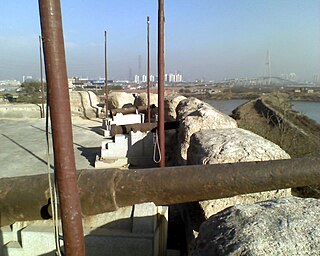
Tianjin, alternately romanized as Tientsin, is a municipality and a coastal metropolis in Northern China on the shore of the Bohai Sea. It is one of the nine national central cities in Mainland China, with a total population of 13,866,009 inhabitants during the 2020 Chinese census. Its built-up area, made up of 12 central districts, was home to 11,165,706 inhabitants and is also the world's 29th-largest agglomeration and 11th-most populous city proper.

Ulan-Ude is the capital city of the Republic of Buryatia, Russia, located about 100 kilometers (62 mi) southeast of Lake Baikal on the Uda River at its confluence with the Selenga. According to the 2021 Census, 437,565 people lived in Ulan-Ude; up from 404,426 recorded in the 2010 Census, making the city the third-largest in the Russian Far East by population.

The Boxer Rebellion, also known as the Boxer Uprising, the Boxer Insurrection, or the Yihetuan Movement, was an anti-foreign, anti-colonial, and anti-Christian uprising in China between 1899 and 1901, towards the end of the Qing dynasty, by the Society of Righteous and Harmonious Fists, known as the "Boxers" in English because many of its members had practised Chinese martial arts, which at the time were referred to as "Chinese boxing".

Omsk is the administrative center and largest city of Omsk Oblast, Russia. It is situated in southwestern Siberia, and has a population of over 1.1 million. Omsk is the third largest city in Siberia after Novosibirsk and Krasnoyarsk, and the twelfth-largest city in Russia. It is an essential transport node, serving as a train station for the Trans-Siberian Railway and as a staging post for the Irtysh River.

Samara, known from 1935 to 1991 as Kuybyshev, is the largest city and administrative centre of Samara Oblast. The city is located at the confluence of the Volga and the Samara rivers, with a population of over 1.14 million residents, up to 1.22 million residents in the urban agglomeration, not including Novokuybyshevsk, which is not conurbated. The city covers an area of 541.382 square kilometers (209.029 sq mi), and is the eighth-largest city in Russia and tenth agglomeration, the third-most populous city on the Volga, as well as the Volga Federal District.

Arkhangelsk, also known in English as Archangel and Archangelsk, is a city and the administrative center of Arkhangelsk Oblast, Russia. It lies on both banks of the Northern Dvina near its mouth into the White Sea. The city spreads for over 40 kilometres (25 mi) along the banks of the river and numerous islands of its delta. Arkhangelsk was the chief seaport of medieval and early modern Russia until 1703, when it was replaced by the newly-founded Saint Petersburg.

The Second Opium War, also known as the Second Anglo-Sino War, the Second China War, the Arrow War, or the Anglo-French expedition to China, was a colonial war lasting from 1856 to 1860, which pitted the British Empire and the French Empire against the Qing dynasty of China.

Shlisselburg, formerly Oreshek (Орешек) (1323–1611) and Petrokrepost (Петрокрепость) (1944–1992), is a town in Kirovsky District of Leningrad Oblast, Russia, located at the head of the Neva River on Lake Ladoga, 35 kilometers (22 mi) east of St. Petersburg. Population: 13,170 (2010 Census); 12,401 (2002 Census); 12,589 (1989 Census).

The Taku Forts or Dagu Forts, also called the Peiho Forts are forts located by the Hai River estuary in the Binhai New Area, Tianjin, in northeastern China. They are located 60 km (37 mi) southeast of the Tianjin urban center.

The Eight-Nation Alliance was a multinational military coalition that invaded northern China in 1900 with the stated aim of relieving the foreign legations in Beijing, then besieged by the popular Boxer militia, who were determined to remove foreign imperialism in China. The Allied forces consisted of about 45,000 troops from the eight nations of Germany, Japan, Russia, Britain, France, the United States, Italy, and Austria-Hungary. Neither the Chinese nor the foreign allies issued a formal declaration of war.

Totma is a town and the administrative center of Totemsky District in Vologda Oblast, Russia, located on the left bank of the Sukhona River at its confluence with the Pesya Denga, 217 kilometers (135 mi) northeast of Vologda, the administrative center of the oblast. Population: 9,785 (2010 Census); 10,531 (2002 Census); 10,622 (1989 Census).

The Battle of Peking, or historically the Relief of Peking, was the battle fought on 14–15 August 1900 in Peking, in which the Eight-Nation Alliance relieved the siege of the Peking Legation Quarter during the Boxer Rebellion. From 20 June 1900, Boxers and Imperial Chinese Army troops had besieged foreign diplomats, citizens and soldiers within the legations of Austria-Hungary, Belgium, Britain, France, Italy, Germany, Japan, Netherlands, Russia, Spain and the United States.

The Battle of the Taku or Dagu Forts was a short engagement during the Boxer Rebellion between the Chinese Qing dynasty military and forces belonging to Eight Nation Alliance in June 1900. Western and Japanese naval forces captured the Taku forts after a brief but bloody battle with units of the Qing dynasty. Their loss prompted the Qing government to side with the Boxers while the Chinese army was ordered to resist all foreign military forces within Chinese territory. Allied powers remained in control of the forts until the end of the Boxer Rebellion in September 1901.

Binhai, officially known as Binhai New Area, is a sub-provincial district and state-level new area within the jurisdiction of Tianjin Municipality in the People's Republic of China.
Often described as China's first railway, the first 1,435 mmstandard gauge railway to be built and survive in China was the Kaiping (開平) colliery tramway located at Tongshan in Hebei province. However, this was not the first railway in China. An earlier attempt to introduce railways had been made in 1876 when the short Shanghai to Wusong narrow gauge line known as the "Woosung Road Company" was built but then pulled up within less than two years because of Chinese government opposition.

The Battle of Yangcun was a battle during the march of Eight-Nation Alliance forces from Tianjin to Beijing during the Boxer Rebellion. The Alliance forces defeated the Qing and were able to continue their march towards Peking.

The siege of the International Legations occurred in 1900 in Peking, the capital of the Qing Empire, during the Boxer Rebellion. Menaced by the Boxers; an anti-Christian anti-foreign peasant movement, 900 soldiers, sailors, marines, and civilians, largely from Europe, Japan, and the United States, and about 2,800 Chinese Christians took refuge in the Peking Legation Quarter. The Qing government took the side of the Boxers after the Eight-Nation Alliance invaded Tianjin at the Battle of the Taku Forts (1900), without a formal declaration of war. The foreigners and Chinese Christians in the Legation Quarter survived a 55-day siege by the Qing Army and Boxers. The siege was broken by an international military force, which marched from the coast of China, defeated the Qing Army, and occupied Peking. The siege was called by the New York Sun "the most exciting episode ever known to civilization."

The Russian invasion of Manchuria occurred in the aftermath of the First Sino-Japanese War (1894–1895) when concerns regarding Qing China's defeat by the Empire of Japan, and Japan's brief occupation of Liaodong, caused the Russian Empire to speed up their long held designs for imperial expansion across Eurasia.

Peking–Mukden Railway was a 19th-century steam powered trunkline connecting Peking (Beijing) and Mukden through Tianjin, northeastern Hebei, and southwestern Liaoning; it was a crucial railway in North China and Northeast China.
Konstantin V Tserpitsky was a Russian commander, lieutenant general, participant in the campaigns of 1873, 1875–1876, 1878 and 1880 in Turkestan, the Chinese campaign of 1900-1901 and the Russo-Japanese War of 1904-1905. He distinguished himself during the suppression of the Boxer Uprising (1900-1901). Brother of General Tserpitsky V.V., who died during the defense of Port Arthur.
















